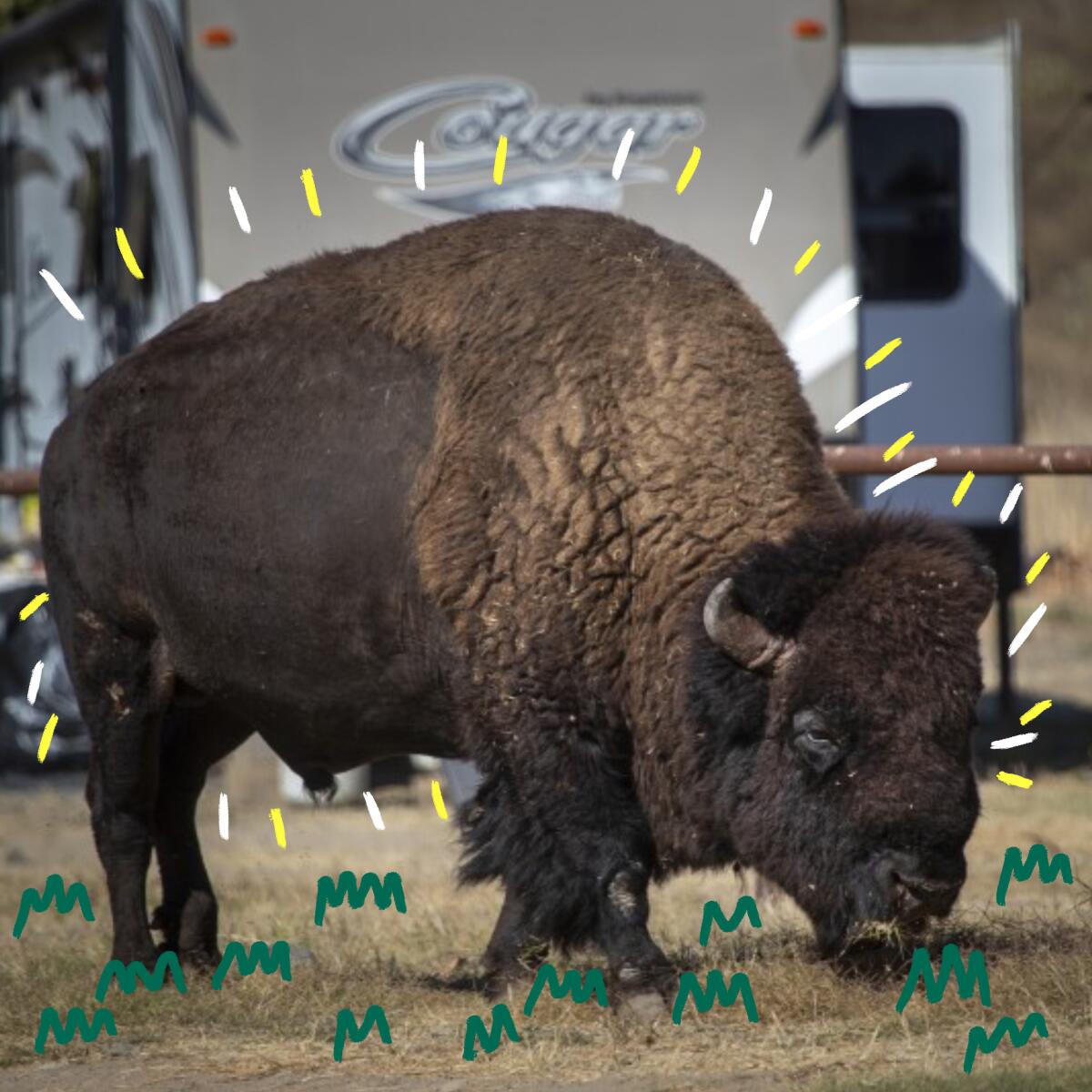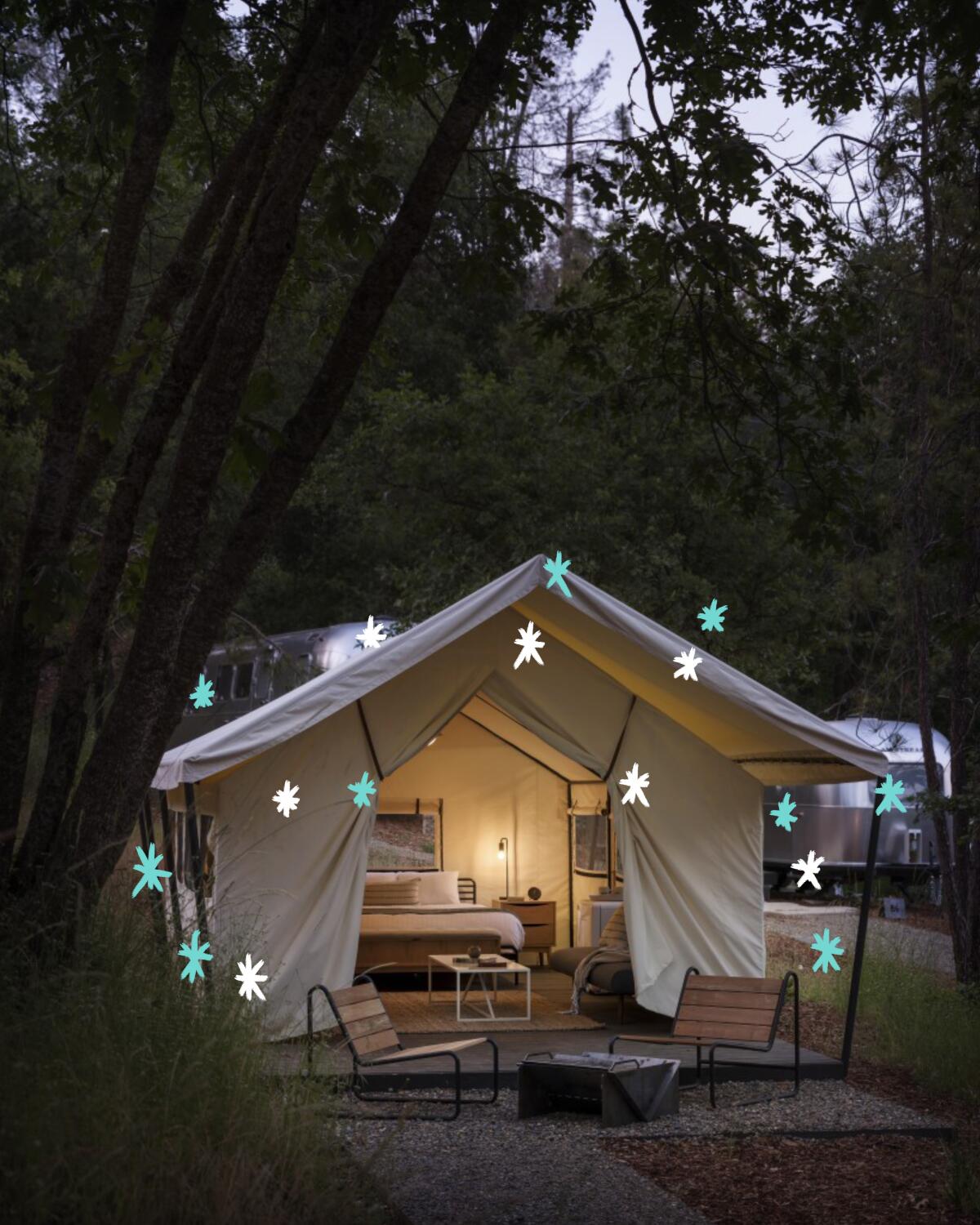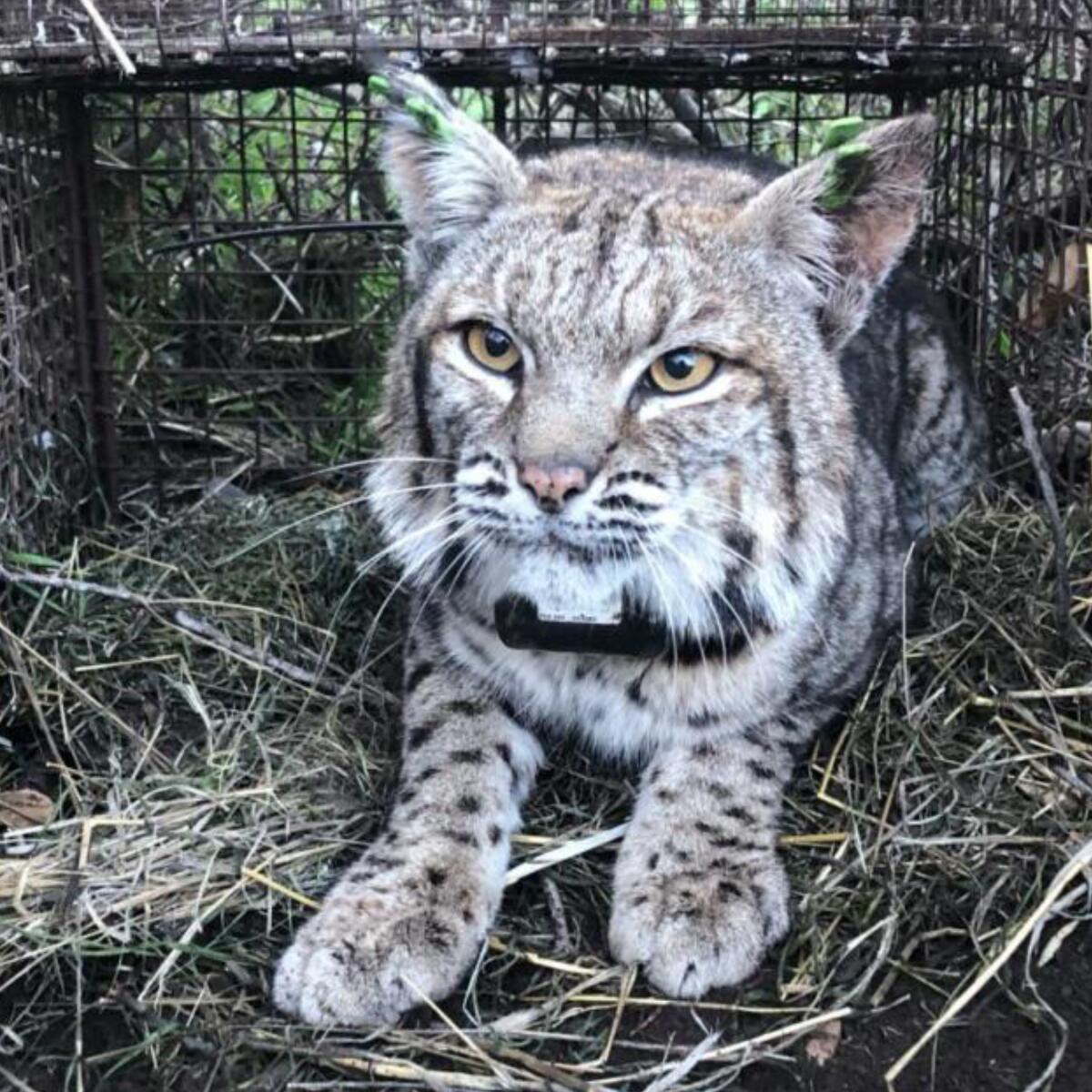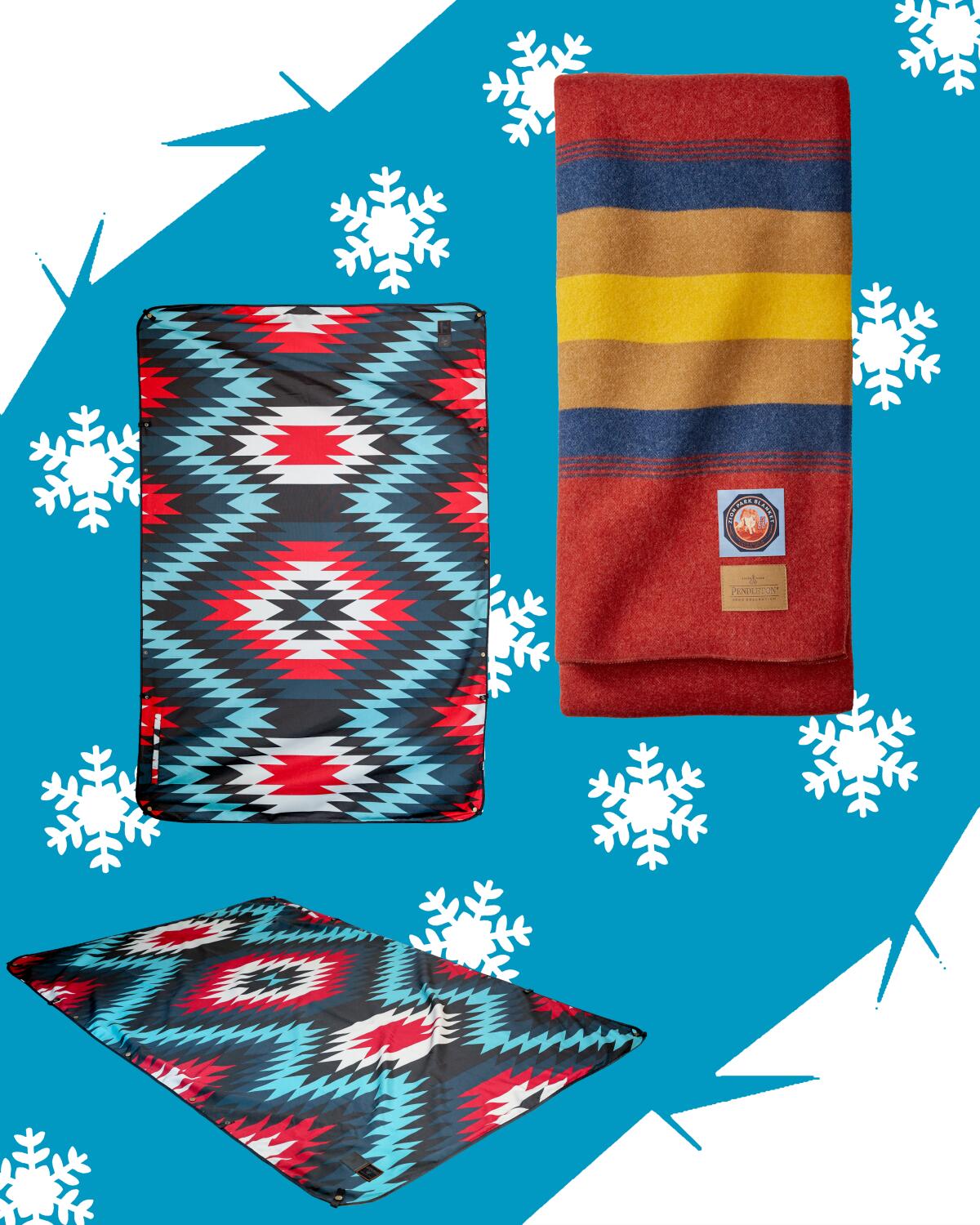7 cushy glamping spots to try in California

- Share via
By Mary Forgione
Design and illustrations by Micah Fluellen
Sign up here to get The Wild sent weekly to your inbox.
Each spring, I wind up hiking on a stretch of the mighty Pacific Crest Trail, the 2,650-mile route from Mexico to Canada that runs through Southern California’s mountains and deserts. I occasionally meet determined hikers carrying loads bigger than my day pack.
“Where are you headed?” I usually ask.
“Canada,” is the reply.
The response always shocks me, a reminder that freedom to roam exists in our wild backyard just beyond L.A.’s freeways. “Take me with you,” I want to shout.
The PCT, as it’s called, starts on the Mexican border and meanders through California, Oregon and Washington. There’s an entire nonprofit organization, the Pacific Crest Trail Assn., devoted to telling people everything they need to know to complete the trail.
Guidebooks point you to the route; stories, even the chilling ones, inspire you to go. Barney “Scout” Mann knows that. His recently published book “Journeys North: The Pacific Crest Trail” documents his experience in 2007. By the way, “Scout” is his trail name, bestowed on him by other hikers.
Mann knows the trail from many perspectives: He has hiked it, served as board chair of the trail association and volunteered as a “trail angel” to helps hikers on the walk of their lives. The experience differs every year. Sometimes snow blocks the route at high Sierra passes well into the summer, sometimes fires force hikers to lose time on detours, sometimes lack of water in the desert is too much to bear.
The trail shot to fame when Cheryl Strayed wrote “Wild,” a 2012 memoir so raw that walking the PCT sounded like the easy part. Then 26 and alone, Strayed strained under the weight of her mother’s death as she ground out the miles.
Mann’s book tells the story of the big walk with his wife and four others. There’s anguish, there’s love, there’s Nutella and there are miles and miles to cover. What better escape could there be during a pandemic? Info: “Journeys North: The Pacific Crest Trail”
3 things to plan this week
It may be tough to take a beach stroll or bike-path ride on Labor Day weekend while trying to social distance. Expect beaches, trails and parks to be more crowded than usual because we all want to be outside during these hot end-of-summer days. If you can find a quiet spot where you feel safe, go for it. If you see too many people at your destination, go somewhere else or stay in your backyard — and put one or two of these activities on your calendar.

1. See a herd of bison on Santa Catalina Island (but don’t get too close). The once-ubiquitous American bison (scientifically known as bison bison bison) first appeared on U.S. nickels in 1913. President Barack Obama made them our national mammal in 2016.
The largest North American mammal roams freely on Santa Catalina Island, an hour’s boat ride from L.A. The shaggy, bearded beasts aren’t true islanders. Hollywood brought 14 bison to the island for a movie shoot in 1924 — and left them. Their numbers grew and expanded to as many as 500 in the late 1990s. The sweet spot for a sustainable herd is 150, given the size of the island. Biologists have had luck with a contraception program that keeps the number of animals in check.
Today, bison cut a rugged profile amid the chaparral-covered hills on the less inhabited side of the island. I know because I accidentally ran into a herd on a recent hike. Read the full story here.

2. Go cushy camping in California without leaving your pandemic bubble. Ever wonder how glam those glamping campsites really are? We looked at a handful around the state that vary in price and amenities. For example, AutoCamp near Yosemite National Park will put you in a luxury tent with a king-sized bed and “a mini-fridge, fan, heater, sofa and a small private deck with fire pit and grill” (starting at $279 a night). A few places in Big Sur add wooden decks and Adirondack chairs to your yurt or safari tent experience ($240 to $625 a night). Here are seven glamping spots to consider when your cabin fever gets to be too much.

3. Find out why white sharks really do love Southern California beaches. You could learn a lot by tracking white sharks. Chris Lowe did. The marine biology professor and director of CalState Long Beach’s Shark Lab discovered that sharks like to use our beaches as a nursery for their young.
Still there’s a lot we don’t know about the largest predatory fish on the planet, such as how many are there and how vulnerable is their population. Each weighs in at more than 2½ tons and has “300 serrated, triangular teeth arranged in several rows,” according to National Geographic. Want to know more? Join a webinar in which Lowe explains why white sharks behave the way they do and what risks they pose to beach-goers. The Santa Barbara Maritime Museum sponsors the free event on Sept. 17 from 7 to 8:30 p.m. Register in advance here.
The must-read

A onetime healthy bobcat in the local mountains recently died from rat poisoning. “We basically never see this in bobcats, so this is an important finding,” biologist Joanne Moriarty said in a statement from the Santa Monica Mountains National Recreation Area. The collared cat known as B-372 is the second bobcat in 23 years to die of anticoagulant toxicosis, whose calling card is internal bleeding.
B-372’s fatal move was hanging out in residential areas, probably because the 2018 Woolsey Fire destroyed the natural habitat it once called home. Being in closer proximity to people brought it closer to places where household rat poisons are used. It likely ate critters that had eaten the poison. Its emaciated body was found June 20 in Agoura Hills. Read the whole story here.
Mountain lions die from the effects of rat poison too. One was killed in January and two others in October. “Rat poisons are designed to kill low-on-the-food chain rodents by thinning their blood and preventing clotting,” this L.A. Times story said. “They lead to uncontrollable bleeding, and when apex-predator big cats eat the vermin, they ingest the poisons.” Countless birds and other creatures eat the stuff and die too.
What can we do to protect wildlife from poisons we use? Some rodenticides have been banned in California. The state Legislature just passed AB-1788, which outlaws the use of what are called second-generation anticoagulant rodenticides. We each play a role in finding alternatives to rid our homes and yards of pests we don’t want to save wild animals we do want. The California Department of Fish and Wildlife offers these alternative ways to get rid of pests.
Cool gear

Sometimes a blanket isn’t just a blanket. Eco-product maker Coalatree teamed with Utah whiskey-maker High West to create a limited-edition blanket made from recycled materials. The blanket folds into a pouch to become a pillow; it also comes with a hood so you can use it as an emergency poncho. And yes, you can spread it out as a picnic blanket or as a cover-up when you sleep under the stars on a warm night. It costs $83; $30 from each sale is donated to the American Prairie Reserve. Order here. Want to sample the whiskey? You must order it separately. If you do — and post an Insta photo of the bottle and the blanket with @DrinkHighWest, @Coalatree and #WhiskeyWherever — $5 per post goes to the reserve.
Wool blanket-maker Pendleton Woolen Mills just added the Zion National Park blanket to its collection of national park blankets. The deep red bands on the blanket (which come in king- and queen-bed sizes) represent the park’s red-rock beauty. Proceeds from the collection support the National Park Foundation, which in turn helps national parks. It costs $269 to $310 for the wool blanket, $199 for a cotton quilt in the same pattern. Go to pendleton-usa.com.
Insider tip

Full disclosure: I am a big stinky flower fan. In past years, I have dropped everything and run out the door after receiving an email from the Huntington Library in San Marino that a giant corpse flower was about to bloom. I would thrill to the telltale rotting smell while waiting in line to get an up-close look (and sniff).
Now, the world’s largest flower is about to burst. And once again, the Huntington alerted people with an email titled: “Well, it’s official. 2020 stinks.” But none of us will get in on the smell-fest. Something else to blame on the pandemic. My colleague Lisa Boone fills you in on how to watch the bloom from home — maybe even when you’re in that boring Zoom work meeting.
Send us your thoughts
Is anyone doing rooftop camping? I want to hear from you about what you like or what you hate about using a pop-up tent on the roof of your car. Does it ruin or elevate the car camping experience? Keep the comments coming. Share anything that’s on your mind. The Wild is written for you and delivered to your inbox for free. Drop us a line at TheWild@latimes.com.
Click here to view the web version of this newsletter and share with others. I’m Mary Forgione and I write The Wild. I’ve been exploring trails and open spaces in Southern California for four decades.

Sign up for The Wild
We’ll help you find the best places to hike, bike and run, as well as the perfect silent spots for meditation and yoga.
You may occasionally receive promotional content from the Los Angeles Times.




